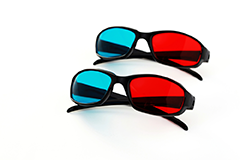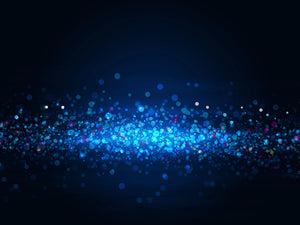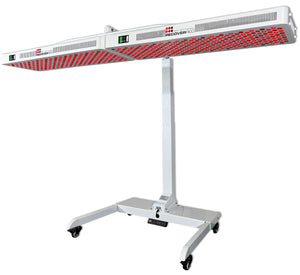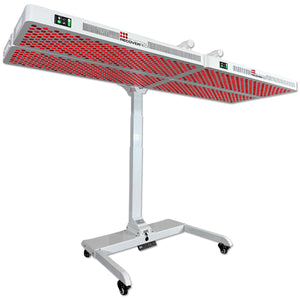Most of us are on a quest to maximize our health. Put simply, this involves decreasing the bad things we expose ourselves to while increasing the good things. But what happens when you can’t even see the things that are damaging your health and wellness?
That’s the case with light – specifically blue light.
In this article, we’ll discuss blue light, the good and bad aspects of it, and why it can sometimes necessitate the use of blue light glasses. But we’ll also discuss the red lighting movement and the scientifically proven benefits for red light therapy. So, if you’ve ever wondered why some people prefer wearing glasses with blue light or engaging in red light treatment at home, this article is for you.
The Power of Light
Google terms like “canned light,” “red light home therapy,” or “blue light spectacles,” and you’ll quickly begin to understand the importance that light (of all types and shades) plays in our lives. You may remember from high school science class that light is a fundamental element of our universe. It is composed of photons that travel as waves, and each of these has its own wavelength.
These wavelengths are measured in nanometers, and they span from the visible light spectrum—encompassing red, orange, yellow, green, blue, and violet—to the invisible spectrums of ultraviolet and infrared light. But here’s what you probably didn’t learn in school: each light wavelength carries unique properties that can directly affect human health. In this case, we’re focusing on the lights blue, red, and infrared.
What is Blue Light?
Blue light is a segment of the visible light spectrum, ranging from 400-495 nm. It's almost always around us in some form, as it is emitted on a constant basis by the sun. However, blue light is also emitted by artificial sources like digital screens, LED lights, and fluorescent bulbs. So, your recessed pot lights, office lights, cell phones, and TV screens also emit blue light in high volumes.
It's important to understand that this type of light plays a pivotal role in our lives, influencing our sleep, mood, and overall well-being. But not all blue light is created equal.
Natural vs. Unnatural Blue Light

Risks of Overexposure to Blue Light
This natural blue light is essential for human health, providing benefits from enhanced alertness and mood improvement to circadian rhythm regulation. However, its artificial counterpart poses significant risks. Because blue light exposure signals our brain to suppress melatonin production during the day, it promotes wakefulness and alertness. Therefore, overexposure to artificial blue light, especially after sunset, can disrupt our sleep-wake cycle, delaying melatonin production and impairing sleep quality.
In one study, as little as two hours of exposure to blue light near bedtime slowed or stopped the release of melatonin. But the consequences of prolonged exposure to blue light go much further. Eye strain, potential retina damage, and the risk of macular degeneration are significant concerns associated with excessive blue light exposure. There are also studies linking blue light to increased instances of some types of cancer, depression, and attention issues. Unnatural blue light has also been shown to cause permanent hypoxia in cells, hindering its ability to regenerate properly.
What Are Blue Light Glasses?

Beyond wearing protective eyewear, adjusting screen time, and utilizing device settings to minimize blue light emission can be effective. In fact, many digital devices now offer "night mode" settings that reduce blue light output in the evenings. Lifestyle adjustments, such as increasing natural light exposure during the day and reducing screen time before bedtime, can also help align our bodies with natural circadian rhythms, promoting better sleep and overall health. You might also consider wearing an eye mask or using eye blackout curtains when sleeping to further reduce sleep-disrupting stimuli.
What is Red Light Therapy?
In contrast to the issues presented by blue light, red light offers a host of health benefits. Utilizing red and near-infrared wavelengths, RLT stimulates cellular processes similar to how plants absorb sunlight for photosynthesis. This type of therapy has been shown to dramatically improve energy production at the cellular level. It also promotes cell regeneration, reduces inflammation, and offers a non-invasive, pain-free treatment option for a wide array of conditions.
RLT works through a process known as photobiomodulation, where specific light wavelengths stimulate cellular activity, enhancing the mitochondria's ability to produce energy. This boost in cellular energy production can lead to faster healing, reduced inflammation, and improved performance of various bodily functions.
The Benefits of Red Light Therapy
Over 6,000 published medical studies currently support RLT's various health benefits. However, perhaps one of the most important aspects of home red light therapy is that it has been proven to reduce the effects of blue light exposure. For instance, RLT actually improves sleep quality by enhancing natural melatonin production. So, while it’s still a good idea to minimize blue light and wear blue light blocking glasses, performing red light therapy at home can counteract some of the worst blue light effects.
RLT can also go beyond sleep, helping to reduce symptoms of depression and anxiety, accelerate muscle recovery, reduce inflammation, improve skin health, and even combat hair loss. In fact, the sheer versatility of RLT makes it an invaluable tool in the pursuit of holistic health and well-being.
How to Incorporate Red Light Therapy into Your Routine

Adopting red light home treatment into your daily health regimen involves careful selection of devices and adherence to recommended usage protocols. When choosing an RLT device, you need to carefully consider factors such as wavelength range, device mobility, wattage, and programmability to ensure it meets your specific needs. Remember that optimal benefits from RLT are achieved through tailored treatment plans, which is why it’s important to consider your specific health goals and health conditions.
Conclusion
The interplay of different light wavelengths on our health underscores the importance of understanding and managing our exposure to them. While blue light is crucial for regulating our circadian rhythm and promoting alertness, its artificial sources can have detrimental effects on our sleep and eye health.
On the other hand, red light therapy offers us a wide range of health benefits through its healing wavelengths. By balancing our exposure to these light sources—minimizing harmful blue light at night and harnessing the therapeutic potential of red light—we can adopt a holistic approach to wellness. This not only enhances our immediate health outcomes but also sets the foundation for long-term well-being.




